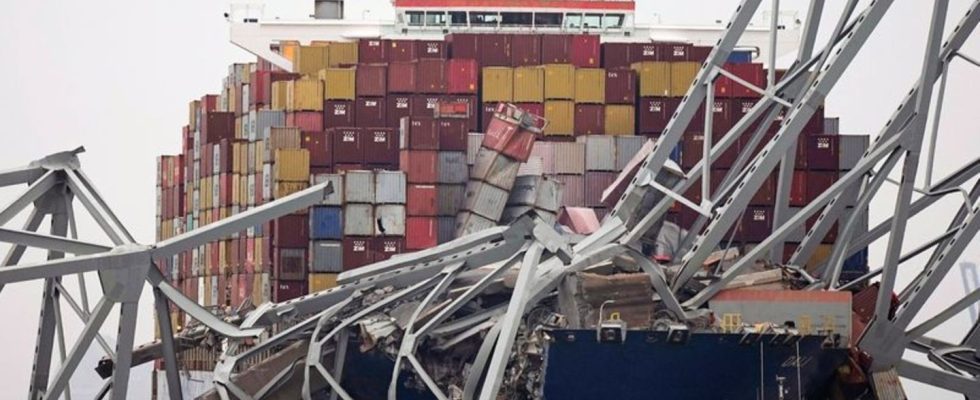Answer questions
Bridge collapse in Baltimore: What we know – and what we don’t
The container ship is stuck under part of the Francis Scott Key Bridge. photo
© Steve Helber/AP/dpa
A freighter rams a highway bridge in the USA, causing it to collapse. Authorities believe the accident cost the lives of six construction workers. The most important questions and answers.
“We will cease our active search and rescue efforts”: With these words, a representative of the US Coast Guard on Tuesday evening (local time) took away any hope that after the collapse of a highway bridge in Baltimore, Maryland, there may still be survivors to be found. Given the temperatures, after so many hours it is no longer expected that anyone will be rescued alive from the cold water.
The night before, a huge container ship had rammed one of the pillars of the Francis Scott Key Bridge. The ship’s crew had made an emergency call before the collision, which may have saved lives – officers on land stopped traffic and prevented more cars from getting onto the bridge. Nevertheless, large parts of the bridge collapsed. Steel girders weighing tons were bent like thin wire by the enormous force, and people and cars were thrown into the depths.
What exactly happened?
According to Maryland Governor Wes Moore, the Singapore-flagged, 290-meter-long container ship “Dali” was heading toward the bridge “at eight knots, i.e. at a rapid speed” – that’s around 15 kilometers per hour. The collision caused the four-lane, more than 2.5 kilometer long bridge to collapse. As part of the national traffic artery Interstate 695, it spanned the port of the east coast metropolis of Baltimore.
According to Maryland Transportation Secretary Paul Wiedefeld, there were eight construction workers on the bridge repairing potholes at the time of the accident. Two people were saved. The remaining six people were considered missing. According to official information, among them are people of Latin American origin, including from Mexico and Guatemala.
Are there any new findings about the cause of the collision?
According to the authorities, there is no evidence of an intentional act or even a terrorist attack. US President Joe Biden spoke of a “terrible accident”. According to initial findings, a problem with the power supply could have been the cause. According to information from Singapore, there was probably a “temporary loss of propulsion”, which is why the ship was unable to maintain its course.
During investigations by the US Transportation Safety Board (NTSB) on the ship, the so-called ship data recorder was secured, as NTSB Chairwoman Jennifer Homendy explained on Wednesday. This is particularly important for research into causes.
Are there any environmental and economic impacts to be feared?
As US media reported, citing the Coast Guard, precautions were taken to keep environmental damage as low as possible. Accordingly, a sheen of oil could be seen on the water. Transportation Secretary Pete Buttigieg also announced that they are preparing for nationwide supply chain problems.
Shipping traffic to the port was suspended until further notice and larger freighters were diverted to a port in the neighboring state of Virginia. According to the US government, the Port of Baltimore is one of the most important maritime ports of call in the USA – especially for the import and export of cars and small trucks.
Would an accident like the one in Baltimore also be possible in Germany?
Experts say something like this can never be ruled out. But there are precautions that make such an accident unlikely in Germany. Bridge construction expert Josef Hegger from the Chair and Institute for Concrete Construction at RWTH Aachen University explained that the Federal Institute for Hydraulic Engineering sets rules as to what impact load pillars must withstand – depending on the shipping route and the size of the ships traveling there. In addition, there are devices on the waterways similar to guard rails that are intended to prevent an impact.
But the most important thing: Bridges in Germany are usually designed in such a way that ships cannot or only with difficulty collide with the pillars.
How many ship collisions with bridges have there been in Germany recently?
Last year, 14 incidents were recorded on federal waterways in which ships touched a bridge superstructure, as the responsible federal waterways and shipping administration announced on Wednesday upon request.
Essentially, these were minor cases in which the top edge of the wheelhouse or parts of the cargo touched the underside of the bridge. “These approaches were insignificant for the statics of the bridge structure,” it continued.

